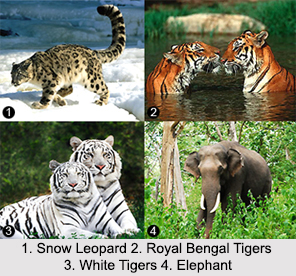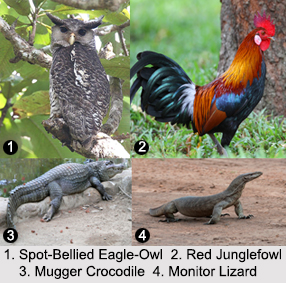 Indian wildlife is a mix of diverse species having varied origins. 10 percent of the world"s species is present in India. Indian wildlife is considered to be one of the richest in the world. India is a vast country with a rich wildlife heritage. Indian wildlife includes numerous animals, mammals, birds, reptiles, etc. They are protected in various national parks and wildlife sanctuaries in the country.
Indian wildlife is a mix of diverse species having varied origins. 10 percent of the world"s species is present in India. Indian wildlife is considered to be one of the richest in the world. India is a vast country with a rich wildlife heritage. Indian wildlife includes numerous animals, mammals, birds, reptiles, etc. They are protected in various national parks and wildlife sanctuaries in the country.
Areas Protecting Indian Wildlife
India has about 103 national parks and 543 wildlife sanctuaries. These parks and sanctuaries spread from Ladakh in the Himalayas to the southern tip of Tamil Nadu. Some of the most important and notable protected areas in India include the Jim Corbett National Park in Uttarakhand, the Kanha National Park and the Bandhavgarh National Park in Madhya Pradesh; the Ranthambhor National Park in Sawai Madhopur (Rajasthan), the Gir National Park in Sasangir (Gujarat). Indian wildlife sanctuaries are attracting people from all over the world, as the rarest of the rare species are found here. Some of the wildlife sanctuaries in India are Nargu Wildlife Sanctuary in Himachal Pradesh, Barda Wildlife Sanctuary in Gujarat, Rajgir Wildlife Sanctuary in Bihar and Chimmony Wildlife sanctuary in Kerala. There are also a number of sanctuaries in India that are specifically dedicated to the preservation of birds. They are called bird sanctuaries. The bird sanctuary at Bharatpur, Rajasthan is one of the most notable sanctuaries in India. It is the second habitat in the world that is visited by Siberian cranes in winter. The sanctuary also provides a vast breeding area to the native water birds.
Different Species of Indian Wildlife
 Animals are a fundamental part of the Indian wildlife. India is considered to be a home to a large number of rare and endangered animal species. Some of the world famous animals in India include the royal Bengal tiger, white tiger, rhinoceros, elephant, lion, snow leopard, black buck and cheetah. Different types of birds found in India are pigeons, peacock, owls, vultures, ducks, junglefowls, adjutants, pelicans, lapwings, parakeets, cuckoos, etc. Reptiles are an integral part of the Indian wildlife. They can be found in every part of the country and they are of numerous types. India is a home to almost 500 species of reptiles. More specifically, reptiles of India constitute about 6.2 percent of the total population of reptiles in the world. Out of this, almost 30 species have been listed as threatened in the IUCN (International Union for Conservation of Nature) red list of threatened animals. Crocodiles live in the rivers, swamps and lakes of India. Some of the most notable reptiles in India include the mugger crocodile, cobra, chameleon, gharial, tortoise, turtle and monitor lizard.
Animals are a fundamental part of the Indian wildlife. India is considered to be a home to a large number of rare and endangered animal species. Some of the world famous animals in India include the royal Bengal tiger, white tiger, rhinoceros, elephant, lion, snow leopard, black buck and cheetah. Different types of birds found in India are pigeons, peacock, owls, vultures, ducks, junglefowls, adjutants, pelicans, lapwings, parakeets, cuckoos, etc. Reptiles are an integral part of the Indian wildlife. They can be found in every part of the country and they are of numerous types. India is a home to almost 500 species of reptiles. More specifically, reptiles of India constitute about 6.2 percent of the total population of reptiles in the world. Out of this, almost 30 species have been listed as threatened in the IUCN (International Union for Conservation of Nature) red list of threatened animals. Crocodiles live in the rivers, swamps and lakes of India. Some of the most notable reptiles in India include the mugger crocodile, cobra, chameleon, gharial, tortoise, turtle and monitor lizard.
Classification of Indian Wildlife
Indian wildlife can be classified as endangered, vulnerable and threatened. These classifications are described below.
Endangered Species
Endangered species are at a risk of becoming extinct because of very low or declining population. There are numerous endangered species in India that are on the verge of extinction. Some of the most important endangered species include the Asiatic lion, Asian elephant, Asiatic black bear, desert cat, great Indian rhinoceros, hispid hare, hoolock gibbon, Kashmir stag, lion-tailed macaque, capped leaf monkey, Nilgiri leaf monkey, markhor, pygmy hog, Andaman shrew, Andaman spiny shrew, nayan ovis, banteng, blue whale, Malabar civet, etc. The critically endangered species in India include the Sumatran rhinoceros, jenkin`s shrew, namdapha flying squirrel, Malabar large-spotted civet, Salim Ali`s fruit bat, wroughton`s free-tailed bat, etc.
Vulnerable Species
Vulnerable species are those which can become endangered, if conditions threatening their existence and reproduction do not improve. Such species in India are blackbuck, Asiatic black bear, brown bear, clouded leopard, grey wolf, dugong, dhole, Asiatic wild dog, brow-antlered deer, eld`s deer, Himalayan musk deer, back-striped weasel, barasingha, jackal canis, bare-bellied hedgehog, Himalayan w-toothed shrew, Himalayan shrew, day`s shrew, argali, Andaman rat, central Kashmir vole, common otter Andaman horseshoe bat, brown fish owl, ganges river dolphin, etc.
Threatened Species
Threatened species are susceptible to endangerment in near future. Such species in India are the Indian wild ass, leopard and red fox.
Conservation of Indian Wildlife
Human encroachment started posing a severe threat to the Indian wildlife. Thus, several conservation measures were initiated by the Government of India. As a result, numerous national parks and wildlife sanctuaries were established in India. In the year 1972, the Wildlife Protection Act was enacted and Project Tiger was initiated by the government, leading to the establishment of tiger reserves in India. The Wildlife Conservation Society (WCS) of India is working in collaboration with other NGO partners and tribal people to preserve the endangered species in India. They are also taking initiatives to develop new models for wildlife conservation with a view to preserve India`s most treasured fauna and also to protect the environment.



















